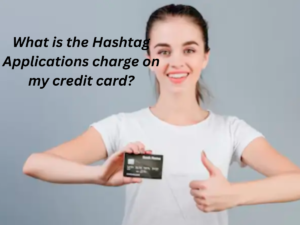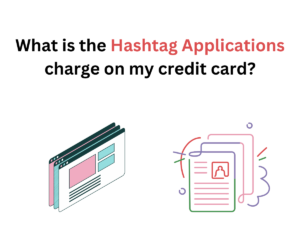It’s normal to see strange charges on your credit card account in the current digital era, where online purchases and subscriptions are the standard. The “Hashtag Applications” cost is one such price that has perplexed a lot of customers. You’re not alone if you’ve just seen this entry on your credit card account and are unsure of its meaning.
This page will go into great detail on the Hashtag Applications charge, including its details, why it appears on your statement, and what to do if you believe it to be fraudulent or unauthorized.
Understanding the Hashtag Applications Charge
The phrase “Hashtag Applications” does not refer to a particular, well-known business or service. Rather, it frequently refers to a subscription or service provided by a third party that bills under this name.
Many businesses employ generic or ambiguous names for their billing descriptions, particularly those that provide digital services like applications, online tools, or subscription-based platforms. Customers may find it challenging to identify the charge’s origin right away as a result of this technique.
Hashtag Applications could be linked to a variety of services, such as:
Mobile Apps or Software Subscriptions: Subscriptions are available for many software applications and mobile apps that offer premium functionality. The transaction may be associated with an ongoing membership cost if you recently downloaded an app or signed up for a free trial.
Online Platforms or Tools: Some internet platforms may be marketed as “Hashtag Applications,” including productivity apps, marketing software, and social media management tools.
Gaming or Entertainment Services: The fee can be associated with any subscriptions you have made to gaming platforms, streaming services, or other entertainment-related businesses.
Fraudulent or Unauthorized Charges: In certain instances, the charge may be the consequence of an illegal transaction or fraudulent behavior. Generic names are frequently used by scammers to make it more difficult for victims to determine the charge’s origin.

Why Does Hashtag Applications Charge Appear on My Statement?
If you don’t recall signing up for a service billed under the name “Hashtag Applications,” there are several possible explanations for why the charge appears on your statement:
Free Trial Conversion: Numerous services provide free trials that, if you don’t cancel before the trial time finishes, automatically turn into paid memberships. You may be billed under the name “Hashtag Applications” if you neglected to cancel.
Recurring Subscription: Certain subscriptions are programmed to automatically renew. The recurring fee may show up under this name if you signed up for a service months ago and forgot about it.
Family or Shared Accounts: It’s possible that someone else has used your credit card to sign up for a service if you share it with friends or relatives.
Hidden Fees or Upsells: Some services include hidden fees or upsells during the checkout process. If you didn’t read the fine print, you might have unknowingly agreed to additional charges.
Fraud or Scams: Unfortunately, credit card fraud is a common issue. Scammers might have obtained your card information and used it to make unauthorized purchases.
How to Identify the Source of the Charge?
If you’re unsure where the Hashtag Applications charge came from, here are some steps you can take to identify the source:
Review Your Recent Purchases: Think back to any apps, services, or subscriptions you’ve signed up for recently. Check your email for confirmation messages or receipts that might provide clues.
Check Your App Store or Google Play Account: If the charge is related to a mobile app, check your purchase history in your app store account (Apple App Store or Google Play Store). This can help you identify the specific app or service.
Search for “Hashtag Applications” Online: A quick online search might reveal other users who have encountered the same charge. Forums like Reddit or consumer complaint websites often have discussions about unfamiliar billing descriptors.
Contact Your Bank or Credit Card Company: Your bank or credit card issuer can provide more information about the charge. They might be able to tell you the merchant’s contact information or help you dispute the charge if it’s unauthorized.
Look for Terms and Conditions: If you suspect the charge is related to a subscription, review the terms and conditions of any services you’ve signed up for. Look for information about billing descriptors and cancellation policies.

What to Do If the Charge Is Unauthorized?
If you’ve determined that the Hashtag Applications charge is unauthorized or fraudulent, take the following steps to protect yourself and resolve the issue:
Contact the Merchant: If you can identify the merchant behind the charge, reach out to their customer support team. Explain the situation and request a refund. Many companies are willing to resolve billing issues promptly.
Dispute the Charge with Your Bank: If you’re unable to resolve the issue with the merchant, contact your bank or credit card issuer to dispute the charge. Most banks have a process for disputing unauthorized transactions, and you may be able to get a refund.
Cancel the Subscription: If the charge is related to a subscription, cancel it immediately to prevent future charges. Check your email for cancellation instructions or visit the service’s website.
Monitor Your Statements: Keep a close eye on your credit card statements for the next few months to ensure no additional unauthorized charges appear.
Report Fraud: If you believe your credit card information has been compromised, report the fraud to your bank and consider requesting a new card with a different number.
Tips to Avoid Unwanted Charges in the Future
To prevent similar issues in the future, follow these best practices:
Read the Fine Print: Before signing up for a free trial or subscription, read the terms and conditions carefully. Pay attention to the billing details and cancellation policy.
Use Virtual Credit Cards: Some banks offer virtual credit cards that generate a unique card number for each transaction. This can help protect your primary card information from being compromised.
Set Reminders for Free Trials: If you sign up for a free trial, set a reminder to cancel before the trial period ends if you don’t want to continue the service.
Regularly Review Your Statements: Make it a habit to review your credit card statements each month. This will help you catch any unfamiliar charges early.
Use Strong Passwords: Protect your online accounts with strong, unique passwords to reduce the risk of unauthorized access.
Conclusion
The “Hashtag Applications” charge on your credit card statement is likely related to a subscription or service you’ve signed up for, though it could also be a sign of fraudulent activity. By taking the time to investigate the charge and follow the steps outlined in this article, you can identify the source of the charge and take appropriate action. Whether it’s canceling a subscription, disputing an unauthorized transaction, or implementing better financial habits, staying proactive is key to protecting your finances in the digital age.
If you’re ever in doubt about a charge on your statement, don’t hesitate to reach out to your bank or credit card issuer for assistance. They are there to help you resolve billing issues and ensure your financial security.
